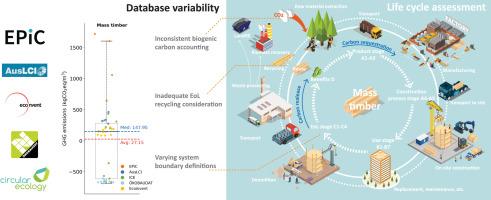大型木结构建筑隐含温室气体(GHG)排放:基于生命周期评估数据库的比较研究
IF 10.9
1区 环境科学与生态学
Q1 ENGINEERING, ENVIRONMENTAL
引用次数: 0
摘要
随着全球在减少建筑运营能耗方面的努力,人们越来越多地将注意力转向减少建筑材料制造和加工过程中产生的温室气体(GHG)排放,特别是对大量木材等新兴材料。具体排放量的量化通常需要使用生命周期评估(LCA)数据库中的温室气体排放系数。然而,在LCA研究的结果中,显著的变异性仍然存在,而其潜在的原因在很大程度上仍未被探索。因此,本研究旨在比较五个广泛使用的LCA数据库(Ecoinvent、AusLCI、EPiC、ICE和ÖKOBAUDAT)中大量木材的隐含温室气体排放数据。通过在材料和建筑层面的详细检查,研究揭示了显著的方法上的不一致,这些不一致造成了实际排放的巨大差异。在材料层面,大量木材的排放范围从-686.80到1718.00千克二氧化碳当量/立方米。建筑级分析(A1-A3)显示,大型木结构建筑的排放范围为-170.31至434.62 kgCO2eq/m2,混凝土建筑的排放范围为69.79至485.95 kgCO2eq/m2。该研究确定了当前大量木材lca面临的几个挑战,包括不一致的生物源碳流处理,不同的系统边界定义,以及对大量木材生命终止(EoL)过程的考虑不足。制造工艺、能源和运输距离的区域差异成为影响数据质量的重要因素。这突出表明有必要建立生物碳核算的标准化方法,实施详细的材料文件系统,并发展更全面和透明的数据库,以提高大量木材LCA的可靠性。本文章由计算机程序翻译,如有差异,请以英文原文为准。

Exploring embodied greenhouse gas (GHG) emissions of mass timber construction: A comparative study of life cycle assessment databases
With global efforts in reducing building operational energy consumption, attention is increasingly turning toward mitigating embodied greenhouse gas (GHG) emissions from building materials manufacturing and processing, particularly for emerging materials like mass timber. Quantifying embodied emissions typically requires the use of GHG emission coefficients from life cycle assessment (LCA) databases. However, significant variability persists in the results of LCA studies while their underlying causes remain largely unexplored. Therefore, this research aims to compare embodied GHG emissions data of mass timber across five widely used LCA databases (Ecoinvent, AusLCI, EPiC, ICE, and ÖKOBAUDAT). Through detailed examination at material and building levels, the research reveals significant methodological inconsistencies that create substantial variations in embodied emissions. At the material level, mass timber emissions span from -686.80 to 1718.00 kgCO2eq/m3. Building-level analysis (A1-A3) reveals emission ranges of -170.31 to 434.62 kgCO2eq/m2 for mass timber construction and 69.79 to 485.95 kgCO2eq/m2 for concrete buildings. The study identifies several challenges in current mass timber LCAs, including inconsistent treatment of biogenic carbon flow, varying system boundary definitions, and inadequate consideration of End-of-Life (EoL) processes for mass timber. Regional variations in manufacturing processes, energy sources, and transportation distances emerge as essential factors influencing data quality. This highlights the need for establishing standardized approaches for biogenic carbon accounting, implementing detailed material documentation systems, and developing more comprehensive and transparent databases to enhance the reliability of mass timber LCA.
求助全文
通过发布文献求助,成功后即可免费获取论文全文。
去求助
来源期刊

Resources Conservation and Recycling
环境科学-工程:环境
CiteScore
22.90
自引率
6.10%
发文量
625
审稿时长
23 days
期刊介绍:
The journal Resources, Conservation & Recycling welcomes contributions from research, which consider sustainable management and conservation of resources. The journal prioritizes understanding the transformation processes crucial for transitioning toward more sustainable production and consumption systems. It highlights technological, economic, institutional, and policy aspects related to specific resource management practices such as conservation, recycling, and resource substitution, as well as broader strategies like improving resource productivity and restructuring production and consumption patterns.
Contributions may address regional, national, or international scales and can range from individual resources or technologies to entire sectors or systems. Authors are encouraged to explore scientific and methodological issues alongside practical, environmental, and economic implications. However, manuscripts focusing solely on laboratory experiments without discussing their broader implications will not be considered for publication in the journal.
 求助内容:
求助内容: 应助结果提醒方式:
应助结果提醒方式:


